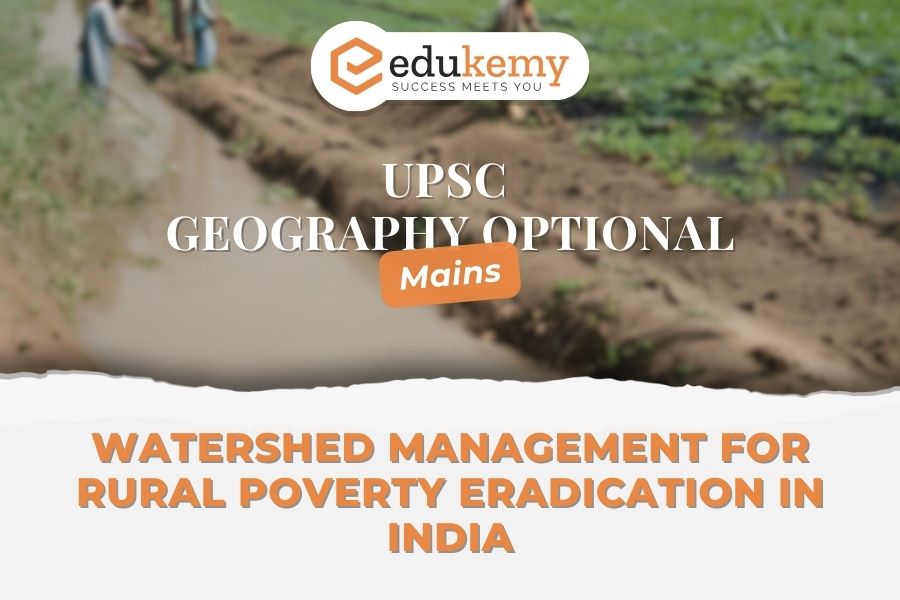
Explore the transformative role of watershed management in alleviating rural poverty across India. Delve into how sustainable land and water resource management strategies empower local communities economically and socially. Understand the integrated approach of watershed projects, promoting agriculture, livestock, and livelihood diversification. Analyze success stories showcasing increased crop yields, income generation, and enhanced resilience to climate variability. Discover how community participation and capacity building foster ownership and sustainability of watershed initiatives. Gain insights into the holistic impact of watershed management on poverty eradication, emphasizing its potential to uplift marginalized rural populations and catalyze inclusive development pathways in India.
Contents
Answer:
Introduction:
Watershed management refers to the efficient and sustainable management of natural resources within a specific geographical area, usually defined by the flow of water. It involves various activities such as soil conservation, afforestation, water harvesting, and community participation aimed at improving water availability, soil fertility, and overall ecosystem health.
Body:
- Water Security: Watershed management ensures reliable access to water for irrigation, drinking, and livestock, thereby enhancing agricultural productivity and food security.
- For instance, the watershed management initiatives in the drought-prone regions of Rajasthan have transformed arid lands into fertile agricultural fields through water conservation techniques like check dams and contour trenching.
- Soil Conservation: By implementing measures like contour plowing, bunding, and afforestation, watershed management prevents soil erosion, improves soil fertility, and enhances crop yields.
- In states like Madhya Pradesh and Maharashtra, watershed development projects have led to increased agricultural income by conserving soil and moisture.
- Livelihood Diversification: Watershed management promotes livelihood diversification by introducing alternative income-generating activities such as horticulture, animal husbandry, and agroforestry.
- In the Biligiri Rangaswamy Temple Tiger Reserve area of Karnataka, watershed development programs have facilitated the cultivation of high-value crops like vanilla and coffee, providing additional sources of income to rural households.
- Community Empowerment: Through participatory approaches, watershed management fosters community ownership and decision-making, empowering marginalized rural communities.
- In Andhra Pradesh, the Neeru-Meeru program has empowered women and marginalized groups by involving them in the planning and implementation of watershed projects, leading to inclusive development and poverty reduction.
- Natural Resource Governance: Watershed management enhances the sustainable use of natural resources by promoting practices such as agroecology and sustainable forestry.
- In the Himalayan region, initiatives like the Integrated Watershed Management Program (IWMP) have helped in mitigating soil erosion, conserving biodiversity, and improving the resilience of mountain communities to climate change impacts.
- Infrastructure Development: Watershed management projects often involve the construction of infrastructure such as check dams, percolation tanks, and irrigation channels, which not only conserve water but also create employment opportunities for rural laborers.
- In Telangana, the Mission Kakatiya program has revived thousands of water bodies through community participation, thereby enhancing rural livelihoods and reducing poverty.
- Risk Mitigation: Watershed management reduces the vulnerability of rural communities to natural disasters such as floods and droughts by improving water retention capacity and ecosystem resilience.
- For example, in the flood-prone areas of Assam, watershed development initiatives have minimized the impact of floods by restoring degraded wetlands and floodplains, safeguarding lives and livelihoods.
Looking ahead, integrating watershed management with technology and climate-smart agriculture practices can further enhance its effectiveness in eradicating rural poverty in India.
Conclusion:
By prioritizing investments in watershed management as a poverty alleviation strategy, India can achieve inclusive and resilient rural development in the years to come.
In case you still have your doubts, contact us on 9811333901.
For UPSC Prelims Resources, Click here
For Daily Updates and Study Material:
Join our Telegram Channel – Edukemy for IAS
- 1. Learn through Videos – here
- 2. Be Exam Ready by Practicing Daily MCQs – here
- 3. Daily Newsletter – Get all your Current Affairs Covered – here
- 4. Mains Answer Writing Practice – here

